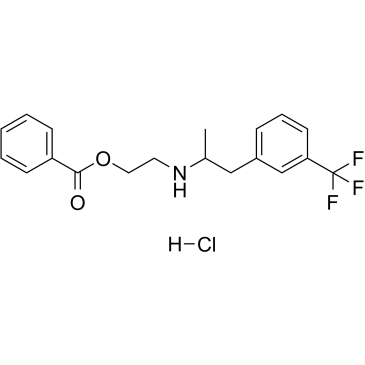23642-66-2
| Name | benfluorex hydrochloride |
|---|
| Description | Benfluorex hydrochloride (JP-992 hydrochloride) is a hepatic nuclear factor 4 alpha (HNF4α) activator. |
|---|---|
| Related Catalog | |
| Target |
HNF4α[1] |
| In Vitro | Benfluorex hydrochloride consistently activates insulin promoter activity as measured by an increased number of GFP-positive cells. Benfluorex hydrochloride increases the number of GFP-positive cells in a dose-responsive manner and increases the level of endogenous insulin mRNA. Consistent with being HNF4α activator, Benfluorex hydrochloride stimulates HNF4α expression. Benfluorex hydrochloride alters HNF4α protease sensitivity, while the inactive control compound does not[1]. Benfluorex hydrochloride decreases, in a concentration-dependent manner, the synthesis of acid-soluble products and ketone bodies from oleate, whereas the production of 14CO2 into citric acid cycle is markedly increased by Benfluorex hydrochloride. Benfluorex hydrochloride inhibits in a dose-dependent manner the rates of gluconeogenesis from lactate/pyruvate (10/1 nM)[2]. |
| Kinase Assay | HepG2 cells are treated with DMSO or Benfluorex hydrochloride at a concentration of 20 µM or 40 µM for 16 hr.Total cell protein is extracted, measured by BCA protein assay. Each sample is split into two aliquots for proteolysis without (-) or with (+) Subtilisin. Twenty ug of cell lysate is incubated with or without protease (20 ng/mL subtilisin) for 35 minutes at room temperature. Western blot is then performed with primary anti-HNF4α polyclonal antibody (1:1000 dilution) and secondary HRP conjugated anti-goat IgG (1:2000 dilution), detected with chemiluminescence ECL kit[1]. |
| Cell Assay | Hepatocytes are isolated by in situ perfusion of the liver with 0.025% collagenase. Hepatocytes (1 to 2×106 cells/mL) are incubated at 37°C in 2 mL of oxygenated (O2:CO2; 95:5) Krebs-Henseleit bicarbonate buffer (pH 7.4) for 1 h in a gyratory shaking water bath. Benfluorex hydrochloride is dissolved in DMSO and added (10 μL) to the incubation medium at a final concentration of 0.1 or 1 nM[2]. |
| References |
| Density | 1.183g/cm3 |
|---|---|
| Boiling Point | 420.5ºC at 760mmHg |
| Melting Point | 158-159?C |
| Molecular Formula | C19H21ClF3NO2 |
| Molecular Weight | 387.82400 |
| Flash Point | 208.1ºC |
| Exact Mass | 387.12100 |
| PSA | 38.33000 |
| LogP | 5.27590 |
| Vapour Pressure | 2.81E-07mmHg at 25°C |
| Storage condition | Refrigerator |
CHEMICAL IDENTIFICATION
HEALTH HAZARD DATAACUTE TOXICITY DATA
|
| Personal Protective Equipment | Eyeshields;Gloves;type N95 (US);type P1 (EN143) respirator filter |
|---|---|
| Hazard Codes | Xi: Irritant; |
| RIDADR | NONH for all modes of transport |
| WGK Germany | 2 |
| RTECS | KL8275000 |
